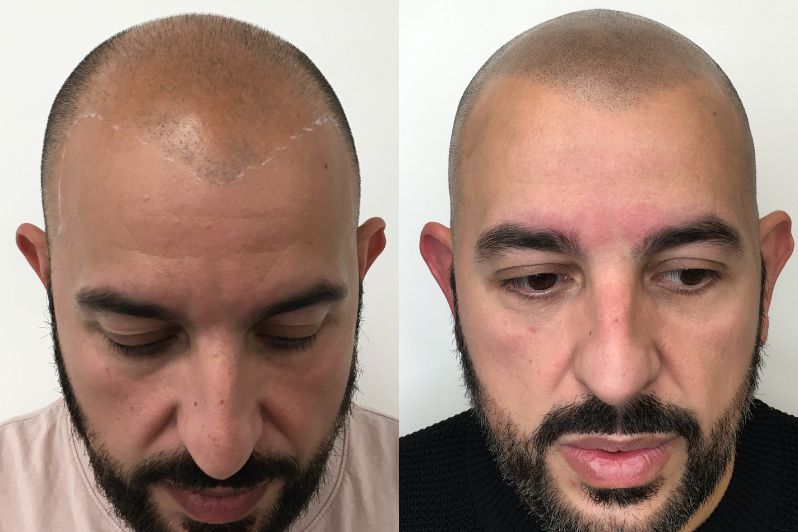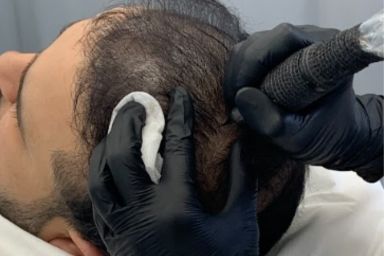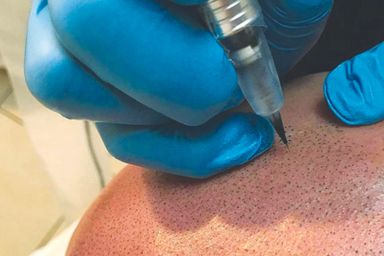Established for over 25 years
Clinics Nationwide
5 Star Google & Trustpilot Reviews
Is Scalp Micropigmentation Permanent?

Reading time: 6 min
Hair loss is a widespread issue affecting both men and women alike, often taking a toll on their self-esteem and personal lives. The emotional impact of losing hair can be significant, as it's closely tied to one's self-confidence and how they perceive themselves.
Fortunately, there have been significant advancements in the field of hair loss treatments. One of the standout options gaining popularity is Scalp Micropigmentation, often referred to as a Hair Tattoo or Scalp Tattooing.
What sets Scalp Micropigmentation apart is its combination of long-lasting results, remarkable effectiveness, and non-surgical nature.
A common question frequently arises around this procedure: Is Scalp Micropigmentation (SMP) permanent? If you've been researching SMP, you've likely encountered conflicting claims from different artists. This article aims to clarify the confusion so that you can make an informed decision.
Table of Content
The primary goal of Scalp Micropigmentation (SMP) is to conceal hair loss by delicately implanting single 'dots' into the surface of the scalp. SMP replicates the natural appearance of real hair follicles by depositing pigment into the skin using a very fine needle.
Each implantation is strategically placed to recreate the natural look of a full head of hair, whether it's for a clean-shaved appearance, to add density to thinning hair, or to camouflage scar tissue. A digital device and safe needles are used to implant pigment/ink, precisely colour-matched to your skin and hair, ensuring a natural and effective final result.
SMP is an effective solution for both men and women, addressing various hair loss conditions and concerns.

Photo showing before and after SMP procedure with FTG Clinics
While Scalp Micropigmentation (SMP) is sometimes referred to as Scalp Tattooing, it's important to note that it is not the same as a traditional tattoo. The initial use of the term "Scalp Tattooing" stemmed from the lack of awareness of this treatment at its inception. SMP artists described it as such due to some similarities in the process with traditional body tattoos.
However, there are significant differences:
- SMP pigment is specifically designed to break down naturally over time and fade. It differs from traditional body ink.
- The depth at which the pigment is inserted into the skin is shallower, typically two layers into the dermis, compared to traditional tattoo ink, which goes five layers deep.
- SMP needles are smaller and designed to create the appearance of tiny hair follicles. The technique employed, known as pointillism, sets SMP apart from traditional body tattoos.
When SMP pigment/ink is correctly implanted into the skin, the particles remain permanently, although they are unlikely to be visible forever. High-quality pigments used in Scalp Micropigmentation are designed to lighten and fade gradually over time but retain their original colour. When SMP fades, a touch-up session is necessary to restore its freshness.
On average, Scalp Micropigmentation can last for 2-5 years. After this period, you will likely start to notice minimal lightening of the treatment (not discoloration). In such cases, a "touch-up" session can be scheduled to bring the treatment back to its initial appearance.
Several factors can affect the longevity of Scalp Micropigmentation:
Type of Pigments: SMP uses two types of pigments – semi-permanent and long-lasting. The shorter-term pigments may last around 12 months before needing a colour refresh, while longer-lasting pigments require a touch-up every 2-5 years.
- Sun Exposure: Sun exposure plays a significant role in the gradual fading of SMP. Ultraviolet (UV) rays are known to affect pigments, leading to the loss of colour and vibrancy in SMP treatments.
- Body's Immune System: The body's immune system can also contribute to the fading of SMP pigments over time. This natural process, known as phagocytosis, involves the removal of foreign particles, including SMP pigments. The individual's immune system strength and efficiency can impact the rate at which SMP fades.
- Aftercare: Following the proper aftercare instructions provided by your SMP practitioner is crucial for maintaining long-lasting results. Neglecting proper aftercare can compromise the integrity of the pigments and potentially accelerate fading.
While Scalp Micropigmentation doesn't offer complete "permanence" in terms of requiring touch-ups, it boasts several advantages over other popular hair loss solutions:
- Less Invasive: Unlike hair transplant surgery, which involves extracting and transplanting hair follicles, SMP is a non-surgical procedure. This means minimal discomfort and a faster recovery time.
- Lower Cost: Compared to hair transplants, SMP is generally a more affordable option. This makes it accessible to a wider range of individuals seeking to address hair loss concerns.
- Minimal Maintenance: While SMP requires touch-up sessions to maintain its initial effect, the upkeep is minimal compared to other options. Unlike wigs, which require regular cleaning and styling, or hair transplants, which might involve more rigorous aftercare routines, SMP requires minimal daily maintenance.
Therefore, while SMP requires touch-ups to maintain its initial appearance, it offers a highly practical and long-lasting solution for individuals seeking to address hair loss with minimal invasiveness, cost, and maintenance compared to other options.
Summary
Hair loss solutions like SMP aren't truly "permanent," requiring touch-ups. However, pigment molecules do remain in the skin indefinitely, but the pigments gradually fade over 2-5 years. Unlike traditional tattoos, SMP uses pigments designed to fade, is implanted shallower, and uses finer needles for a realistic hair follicle appearance. While touch-ups are needed, SMP offers a less invasive, affordable, and low-maintenance alternative for addressing hair loss with a natural look.
Does SMP fade evenly?
Generally, yes, SMP fades evenly when performed by a skilled practitioner using high-quality pigments
Is SMP safe?
When performed by a qualified and experienced practitioner using sterile equipment and high-quality pigments, SMP is considered a safe procedure.
How much does SMP cost?
The cost of SMP varies depending on the experience of the practitioner, the complexity of the desired results, and the size of the area being treated.


Combining Scalp Micropigmentation and Hair Transplants: The Ultimate Hair Loss Solution

Eyebrow Hair Loss Demystified: Uncovering Causes and Pursuing Solutions

Can You Use Minoxidil with Scalp Micropigmentation?

Female Temple Hair Loss: Causes, Prevention & Treatment

Paul's Transformation: Navigating Alopecia Universalis with Eyebrow & Scalp Micropigmentation

Scalp Micropigmentation Fading: A Comprehensive Guide

Scalp Micropigmentation: A Solution for Blonde & Fair Hair (Men & Women)

Does Scalp Micropigmentation Damage Hair Follicles?

Botched Scalp Micropigmentation Treatment: What Are Your Options?
- Choosing a selection results in a full page refresh.
- Press the space key then arrow keys to make a selection.


